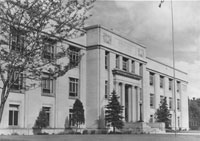Summary 2013 WY 150
Summary of Decision December 10, 2013
Justice Kite delivered the opinion for the Court. Affirmed.
Case Name: THE ESTATE OF JOAN M. MARUSICH v. STATE OF WYOMING, ex rel., DEPARTMENT OF HEALTH, OFFICE OF HEALTHCARE FINANCING/EQUALITYCARE
Docket Number: S-13-0036
URL: http://www.courts.state.wy.us/Opinions.aspx
Appeal from the District Court of Albany County, the Honorable Jeffrey A. Donnell, Judge
Representing Appellant: Craig C. Cook and Dennis C. Cook of Cook & Associates, P.C., Laramie, Wyoming. Argument by Mr. Craig C. Cook.
Representing Appellee: Gregory A. Phillips, Wyoming Attorney General; Robin Sessions Cooley, Deputy Attorney General; Kristin M. Nuss, Senior Assistant Attorney General. Argument by Ms. Nuss.
Date of Decision: December 10, 2013
Facts: After Joan M. Marusich died, the State of Wyoming ex rel. Department of Health, Office of Healthcare Financing/Equalitycare (Department) filed a lien against the home she owned with her husband, William Marusich, as tenants by the entirety. The Department sought to recover the cost of Medicaid benefits paid on behalf of Mr. Marusich, who had predeceased Mrs. Marusich. The Estate of Joan M. Marusich (Marusich Estate) filed a petition to remove a false lien. The district court granted summary judgment in favor of the Department, ruling that under the relevant federal and state laws, the lien was appropriate. After the district court entered a final judgment on the amount of the lien and denied the Marusich Estate’s motion to amend the petition, the estate appealed.
Issues: The Marusich Estate presents the following issues on appeal: Whether property owned by a married couple as tenants by the entireties may be subject to a lien against property in the estate of the surviving spouse for recovery of Medicaid expenses paid solely on behalf of the predeceased spouse. Whether the remedial provisions of W.S. § 29-1-601(b) may be invoked against appellee as claimant on a legally groundless and impermiss[i]ble recorded claim of lien. Whether the district court erred when it denied a motion to amend petition to conform the pleadings to the underlying cause of action in quiet title that was argued by the parties on cross motions for summary judgment. The Department’s issues are similar, though phrased differently.
Holdings/Decision: The district court correctly granted summary judgment upholding the Department’s lien. The district court stated in its decision letter that the Department was entitled to attorney fees and costs and the Department submitted an affidavit in support of its claim, the record does not indicate that the district court ever awarded fees and costs. In fact, the Marusich Estate concedes no such order was ever entered. We will not, therefore, further address the issue of whether the Department was entitled to attorney fees and costs. The quiet title claim propounded by the Marusich Estate was based upon the validity of the Department’s Medicaid lien. In fact, the motion to amend the petition specifically stated that the Marusich Estate “does not seek to amend or alter any factual allegation in its original Petition or prayer for relief. . . . The proposed amendment will not, in any way, alter Petitioner’s legal arguments already presented in this matter.” As the district court properly recognized, the validity of the lien had already been decided. Whether the Marusich Estate’s claim was restyled as a quiet title action or not, the result would be the same. The district court did not abuse its discretion by denying the Marusich Estate’s motion to amend the petition. Affirmed.
Summaries are prepared by Law Librarians and are not official statements of the Wyoming Supreme Court
[SPECIAL NOTE: This opinion uses the "Universal Citation." It was given an "official" citation when it was issued. You should use this citation whenever you cite the opinion, with a P.3d parallel citation. You will also note when you look at the opinion that all of the paragraphs are numbered. When you need to provide a pinpoint citation to a quote the universal portion of the citation will use that paragraph number. The pinpoint citation in the P.3d portion will need to have the reporter page number. If you need assistance in putting together a citation from this, or any future opinion using the Universal Citation form, please contact the Wyoming State Law Library and we will provide any needed assistance]


